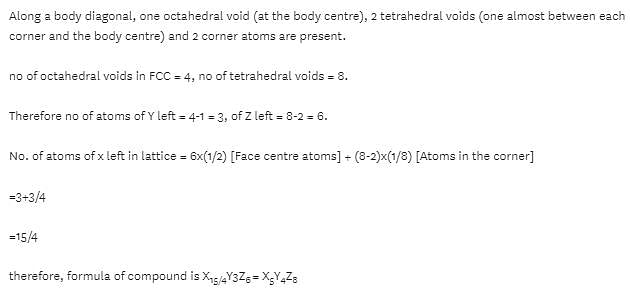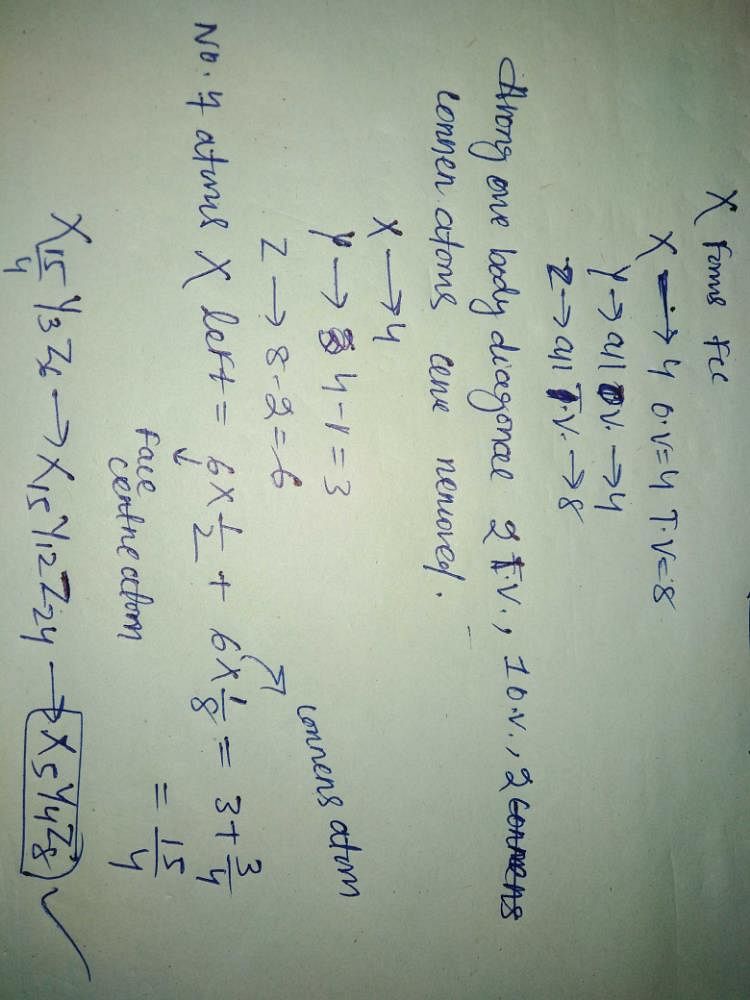IIT JAM Exam > IIT JAM Questions > A crystal is made of particles X, Y and Z. X ...
Start Learning for Free
A crystal is made of particles X, Y and Z. X forms fcc packing. Y occupies all the octahedral voids of X and Z occupies all the tetrahedral voids of X. If all the particles including corner atoms along one body diagonal are removed then the formula of the crystal would be (a) XYZ(2) (b) X(2)Y Z(2) (c) X(8)Y(4)Z(5) (d) X(5)Y(4)Z(8)?
Verified Answer
A crystal is made of particles X, Y and Z. X forms fcc packing. Y occu...
Ans.


 This question is part of UPSC exam. View all IIT JAM courses
This question is part of UPSC exam. View all IIT JAM courses
Most Upvoted Answer
A crystal is made of particles X, Y and Z. X forms fcc packing. Y occu...

Community Answer
A crystal is made of particles X, Y and Z. X forms fcc packing. Y occu...
Crystal Structure:
- The crystal is made up of particles X, Y, and Z.
- Particle X forms a face-centered cubic (fcc) packing.
Occupation of Void Spaces:
- Particle Y occupies all the octahedral voids of X.
- Particle Z occupies all the tetrahedral voids of X.
Removal of Particles:
- All the particles, including corner atoms, along one body diagonal are removed.
Analysis:
- Let's consider one unit cell of the crystal structure.
- In the fcc packing, there are 4 particles at the corners of the unit cell and 4 particles at the face centers.
- Particle X occupies the corner positions, while particle Y occupies the face center positions.
Effect of Removing Particles:
- Removing the particles along one body diagonal means removing particles X, Y, and Z from the unit cell.
- This results in the removal of 1 X particle from the corner and 1 Y particle from the face center along the body diagonal.
- However, the particle Z is not present at the corners along the body diagonal, so it is not removed.
Formula of the Crystal:
- After the removal of particles, we are left with particle Z occupying the tetrahedral voids of X.
- The formula of the crystal can be deduced by counting the remaining particles.
- In the unit cell, there are 4 corner positions and 4 face center positions.
- Since particle Z occupies the tetrahedral voids of X, there are 8 tetrahedral voids in total.
- Therefore, the formula of the crystal is X(5)Y(4)Z(8).
Answer:
The formula of the crystal after removing all particles along one body diagonal is (d) X(5)Y(4)Z(8).
- The crystal is made up of particles X, Y, and Z.
- Particle X forms a face-centered cubic (fcc) packing.
Occupation of Void Spaces:
- Particle Y occupies all the octahedral voids of X.
- Particle Z occupies all the tetrahedral voids of X.
Removal of Particles:
- All the particles, including corner atoms, along one body diagonal are removed.
Analysis:
- Let's consider one unit cell of the crystal structure.
- In the fcc packing, there are 4 particles at the corners of the unit cell and 4 particles at the face centers.
- Particle X occupies the corner positions, while particle Y occupies the face center positions.
Effect of Removing Particles:
- Removing the particles along one body diagonal means removing particles X, Y, and Z from the unit cell.
- This results in the removal of 1 X particle from the corner and 1 Y particle from the face center along the body diagonal.
- However, the particle Z is not present at the corners along the body diagonal, so it is not removed.
Formula of the Crystal:
- After the removal of particles, we are left with particle Z occupying the tetrahedral voids of X.
- The formula of the crystal can be deduced by counting the remaining particles.
- In the unit cell, there are 4 corner positions and 4 face center positions.
- Since particle Z occupies the tetrahedral voids of X, there are 8 tetrahedral voids in total.
- Therefore, the formula of the crystal is X(5)Y(4)Z(8).
Answer:
The formula of the crystal after removing all particles along one body diagonal is (d) X(5)Y(4)Z(8).

|
Explore Courses for IIT JAM exam
|

|
Similar IIT JAM Doubts
A crystal is made of particles X, Y and Z. X forms fcc packing. Y occupies all the octahedral voids of X and Z occupies all the tetrahedral voids of X. If all the particles including corner atoms along one body diagonal are removed then the formula of the crystal would be (a) XYZ(2) (b) X(2)Y Z(2) (c) X(8)Y(4)Z(5) (d) X(5)Y(4)Z(8)?
Question Description
A crystal is made of particles X, Y and Z. X forms fcc packing. Y occupies all the octahedral voids of X and Z occupies all the tetrahedral voids of X. If all the particles including corner atoms along one body diagonal are removed then the formula of the crystal would be (a) XYZ(2) (b) X(2)Y Z(2) (c) X(8)Y(4)Z(5) (d) X(5)Y(4)Z(8)? for IIT JAM 2024 is part of IIT JAM preparation. The Question and answers have been prepared according to the IIT JAM exam syllabus. Information about A crystal is made of particles X, Y and Z. X forms fcc packing. Y occupies all the octahedral voids of X and Z occupies all the tetrahedral voids of X. If all the particles including corner atoms along one body diagonal are removed then the formula of the crystal would be (a) XYZ(2) (b) X(2)Y Z(2) (c) X(8)Y(4)Z(5) (d) X(5)Y(4)Z(8)? covers all topics & solutions for IIT JAM 2024 Exam. Find important definitions, questions, meanings, examples, exercises and tests below for A crystal is made of particles X, Y and Z. X forms fcc packing. Y occupies all the octahedral voids of X and Z occupies all the tetrahedral voids of X. If all the particles including corner atoms along one body diagonal are removed then the formula of the crystal would be (a) XYZ(2) (b) X(2)Y Z(2) (c) X(8)Y(4)Z(5) (d) X(5)Y(4)Z(8)?.
A crystal is made of particles X, Y and Z. X forms fcc packing. Y occupies all the octahedral voids of X and Z occupies all the tetrahedral voids of X. If all the particles including corner atoms along one body diagonal are removed then the formula of the crystal would be (a) XYZ(2) (b) X(2)Y Z(2) (c) X(8)Y(4)Z(5) (d) X(5)Y(4)Z(8)? for IIT JAM 2024 is part of IIT JAM preparation. The Question and answers have been prepared according to the IIT JAM exam syllabus. Information about A crystal is made of particles X, Y and Z. X forms fcc packing. Y occupies all the octahedral voids of X and Z occupies all the tetrahedral voids of X. If all the particles including corner atoms along one body diagonal are removed then the formula of the crystal would be (a) XYZ(2) (b) X(2)Y Z(2) (c) X(8)Y(4)Z(5) (d) X(5)Y(4)Z(8)? covers all topics & solutions for IIT JAM 2024 Exam. Find important definitions, questions, meanings, examples, exercises and tests below for A crystal is made of particles X, Y and Z. X forms fcc packing. Y occupies all the octahedral voids of X and Z occupies all the tetrahedral voids of X. If all the particles including corner atoms along one body diagonal are removed then the formula of the crystal would be (a) XYZ(2) (b) X(2)Y Z(2) (c) X(8)Y(4)Z(5) (d) X(5)Y(4)Z(8)?.
Solutions for A crystal is made of particles X, Y and Z. X forms fcc packing. Y occupies all the octahedral voids of X and Z occupies all the tetrahedral voids of X. If all the particles including corner atoms along one body diagonal are removed then the formula of the crystal would be (a) XYZ(2) (b) X(2)Y Z(2) (c) X(8)Y(4)Z(5) (d) X(5)Y(4)Z(8)? in English & in Hindi are available as part of our courses for IIT JAM.
Download more important topics, notes, lectures and mock test series for IIT JAM Exam by signing up for free.
Here you can find the meaning of A crystal is made of particles X, Y and Z. X forms fcc packing. Y occupies all the octahedral voids of X and Z occupies all the tetrahedral voids of X. If all the particles including corner atoms along one body diagonal are removed then the formula of the crystal would be (a) XYZ(2) (b) X(2)Y Z(2) (c) X(8)Y(4)Z(5) (d) X(5)Y(4)Z(8)? defined & explained in the simplest way possible. Besides giving the explanation of
A crystal is made of particles X, Y and Z. X forms fcc packing. Y occupies all the octahedral voids of X and Z occupies all the tetrahedral voids of X. If all the particles including corner atoms along one body diagonal are removed then the formula of the crystal would be (a) XYZ(2) (b) X(2)Y Z(2) (c) X(8)Y(4)Z(5) (d) X(5)Y(4)Z(8)?, a detailed solution for A crystal is made of particles X, Y and Z. X forms fcc packing. Y occupies all the octahedral voids of X and Z occupies all the tetrahedral voids of X. If all the particles including corner atoms along one body diagonal are removed then the formula of the crystal would be (a) XYZ(2) (b) X(2)Y Z(2) (c) X(8)Y(4)Z(5) (d) X(5)Y(4)Z(8)? has been provided alongside types of A crystal is made of particles X, Y and Z. X forms fcc packing. Y occupies all the octahedral voids of X and Z occupies all the tetrahedral voids of X. If all the particles including corner atoms along one body diagonal are removed then the formula of the crystal would be (a) XYZ(2) (b) X(2)Y Z(2) (c) X(8)Y(4)Z(5) (d) X(5)Y(4)Z(8)? theory, EduRev gives you an
ample number of questions to practice A crystal is made of particles X, Y and Z. X forms fcc packing. Y occupies all the octahedral voids of X and Z occupies all the tetrahedral voids of X. If all the particles including corner atoms along one body diagonal are removed then the formula of the crystal would be (a) XYZ(2) (b) X(2)Y Z(2) (c) X(8)Y(4)Z(5) (d) X(5)Y(4)Z(8)? tests, examples and also practice IIT JAM tests.

|
Explore Courses for IIT JAM exam
|

|
Signup for Free!
Signup to see your scores go up within 7 days! Learn & Practice with 1000+ FREE Notes, Videos & Tests.














